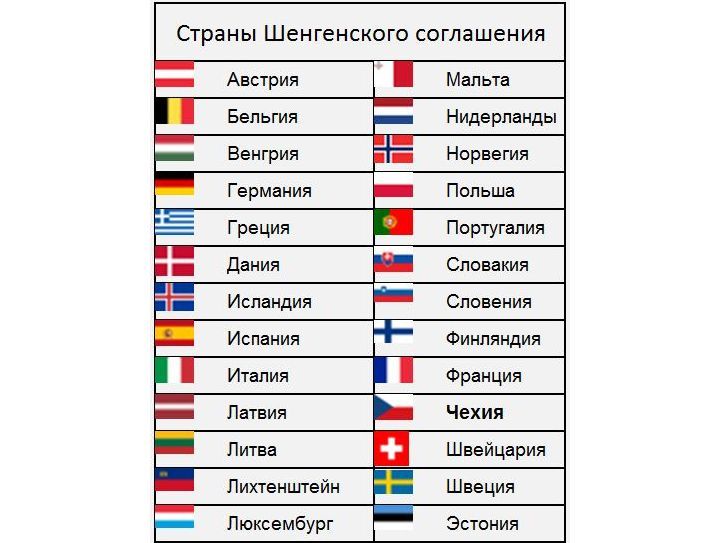The countries of the Schengen zone - a European space with an area of more than 4.3 million km² with common customs regulations and open national borders. Citizens of these countries have the right to move freely within the territory, and a single permit document is provided for visits by foreigners. When planning future trips, travelers will be updated on what the Schengen list looks like in 2020. Are changes in membership expected?
List of countries
For 2020, the list of Schengen countries is as follows:

In addition to this list, the holder of the Schengen multivisa has the right to legally visit a number of countries. They automatically enter the Schengen zone due to their location on the territory of other states:
- Principality of Monaco (France).
- San Marino (Italy).
- Vatican (Italy).
- Andorra (Spain).
At the same time, travelers with single-entry visas should take into account possible problems when visiting these countries. Entering, for example, Andorra, a tourist actually leaves the Schengen zone, respectively, when returning to it, re-issuance of the permit document is required. To enter only the territory of Monaco, Andorra, the Vatican or San Marino, you need a visa, respectively, France, Spain or Italy.
The composition of the Schengen area is not identical to the composition of the European Union. For example, in the UK and Ireland, EU members, their own passport and visa regime is in effect. In addition, the UK is preparing to exit the EU. And such Schengen participants as Iceland, Liechtenstein, Norway and Switzerland are not members of the European Union.
In 2020, the list of Schengen countries can be expanded at the expense of Cyprus, Romania, Bulgaria and Croatia, although their accession has been delayed for one reason or another for more than one year. There is no official information about new members yet. Now for these countries, entry is possible on the basis of the Schengen multivisa, but holders of the national visa of these countries can not enter the Schengen zone. But between them there is an agreement on the mutual recognition of national visa documents. For example, the holder of a Cyprus visa is free to visit Bulgaria, Romania, Croatia and vice versa.

Travel Features
On the Schengen territory, the internal passport and visa control has been canceled, which gives the holder of a multi-visa the possibility of free movement within the zone. Exceptions are possible during major sporting or political events, when interstate borders are sometimes closed for a period of not more than 30 days or more serious passport control rules are introduced, which is associated for foreign citizens with an increase in the time for checking documents. Such measures are associated with cases of terrorist attacks in European countries.
Free movement rules do not apply to remote areas of the Schengen countries. For example, the Danish autonomous regions of Faroe and Greenland, Norwegian Svalbard, French Martinique, the Dutch territories of Aruba and Curacao, etc. Separate permits are issued for visiting these places.
In addition, the authorities of individual states were forced to strengthen border controls in order to reduce the flow of illegal immigrants and increase crime among them. Special rules apply at the following boundaries:
- on the German - with Austria;
- in Austria - with Hungary and Slovenia;
- in Hungarian - with Croatia, Serbia and Slovenia (although the latter refers to the Schengen zone).
- on Danish - with Germany and the ports, which are the place of arrival of German ferries.
- in Swedish - over the Eresun bridge, southern and western ports.
- in Norwegian - with seaports, which are the place of arrival of ferries from Germany, Denmark, Sweden.

What will change in 2020
Starting January 1, 2020, amendments to the Visa Code are scheduled to enter into force, which will affect the procedure for issuing visa documents, including for Russians:
- The maximum period for applying for a visa will increase - 6 months before the date of travel (now only 3), but no later than 15 days in advance. This will reduce the burden on consular services, and tourists will be able to plan travel in advance.
- Travelers will have the opportunity to fill out a visa application electronically without additional conditions or cash expenses. If a particular country has the appropriate tools, it has the right to introduce remote filing of applications.
- Minors will be able to exempt from the visa fee. As before, for children under 6 years of age a fee for issuing a visa is not provided. But since 2020, the Schengen countries will be able at their discretion to make such a decision for children from 6 to 18 years.
- It will be possible to obtain multiple visas with a gradual increase in validity from 1 year to 5 years. The innovation should save time and money costs of the applicants and the Schengen states themselves. Documents of longer validity will be available to return travelers with a positive visa history. For the latter, a prerequisite will be entry into the eurozone on a previously issued short-term visa only through the country that issued it (for example, upon receipt of the Finnish Schengen you need to enter the EU from Finland, and not from another country).
Applicants who have received and legally used 3 short-term visas for the last 2 years will be able to count on an annual visa. To apply for a 2-year document, you must first use at least one version of the annual visa received during the previous two years. For a 5-year multi-visa, for the last 3 years you need to be the owner of a two-year permit.
- The visa fee will increase from February 2, 2020 from 60 to 80 euros, but in 2020 this will not affect Russians due to agreements with the EU on the simplified receipt of Schengen, which provides for a preferential fee of 35 euros.
Read also:




















